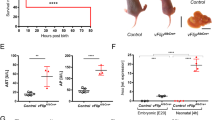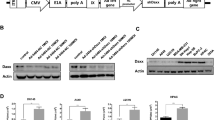Abstract
Replication-deficient adenovirus (Ad vector) is one of the most effective gene transfer systems. However, its employment in human gene therapy trials is hampered by Ad vector associated cytotoxicity and induction of apoptosis of the infected cells. Here, we identify one underlying mechanism as uncoupling of S phase and mitosis of the cell cycle leading to apoptosis and decline of transgene expression. Moreover, we demonstrate a strategy to avoid Ad vector associated cytotoxicity and induction of apoptosis in human primary hepatocytes by coinfection of Ad vector carrying the cDNA of choice and the cell cycle regulator p21WAF1/CIP1 (p21). In addition, animal experiments were performed using Ad vector directed coexpression of p21 and human α 1-antitrypsin. As serum analysis of α 1-antitrypsin after Ad vector mediated gene transfer to the liver of mice revealed, this strategy resulted also in the improvement of transgene expression by two orders of magnitude. These data suggest that coexpression of p21 and Ad vector carrying a therapeutic gene may be a promising strategy to avoid cytotoxicity and induction of apoptosis leading to improved safety in human gene therapy.
This is a preview of subscription content, access via your institution
Access options
Subscribe to this journal
Receive 12 print issues and online access
$259.00 per year
only $21.58 per issue
Buy this article
- Purchase on Springer Link
- Instant access to full article PDF
Prices may be subject to local taxes which are calculated during checkout







Similar content being viewed by others
References
Strauss M . Liver-directed gene therapy: prospects and problems. Gene Ther 1994; 1: 156–164.
Ilan Y, Saito H, Thummala NR, Chowdhury NR . Adenovirus-mediated gene therapy of liver diseases. Semin Liver Dis 1999; 19: 49–59.
Smith TA et al. Adenovirus mediated expression of therapeutic plasma levels of human factor IX in mice. Nat Genet 1993; 5: 397–402.
Kay MA et al. In vivo hepatic gene therapy: complete albeit transient correction of factor IX deficiency in hemophilia B dogs. Proc Natl Acad Sci USA 1994; 91: 2353–2357.
Gao GP, Yang Y, Wilson JM . Biology of adenovirus vectors with E1 and E4 deletions for liver-directed gene therapy. J Virol 1996; 70: 8934–8943.
Yang Y, Greenough K, Wilson JM . Transient immune blockade prevents formation of neutralizing antibody to recombinant adenovirus and allows repeated gene transfer to mouse liver. Gene Ther 1996; 3: 412–420.
Yang Y et al. Immune responses to viral antigens versus transgene product in the elimination of recombinant adenovirus-infected hepatocytes in vivo. Gene Ther 1996; 3: 137–144.
Armentano D et al. E4ORF3 requirement for achieving long-term transgene expression from the cytomegalovirus promoter in adenovirus vectors. J Virol 1999; 73: 7031–7034.
Gorziglia MI et al. Generation of an adenovirus vector lacking E1, E2a, E3, and all of E4 except open reading frame 3. J Virol 1999; 73: 6048–6055.
Wersto RP et al. Recombinant, replication-defective adenovirus gene transfer vectors induce cell cycle dysregulation and inappropriate expression of cyclin proteins. J Virol 1998; 72: 9491–9502.
Teodoro JG, Branton PE . Regulation of apoptosis by viral gene products. J Virol 1997; 71: 1739–1746.
Bilbao G et al. Adenovirus-mediated gene expression in vivo is enhanced by the antiapoptotic bcl-2 gene. J Virol 1999; 73: 6992–7000.
Gartel AL, Tyner AL . The growth-regulatory role of p21(WAF1/CIP1). In: Maciera-Coelhos A (ed). Progress in Molecular and Subcellular Biology, Vol 1. Springer: Berlin, Heidelberg, 1998, pp 43–71.
Niculescu A et al. Effects of p21 (Cipl/Waf1) at both the G1/S and the G2/M cell cycle transitions: pRb is a critical determinant in blocking DNA replication and in preventing endoreduplication. Mol Cell Biol 1998; 18: 629–643.
Medema RH, Klompmarker R, Smits VA, Rijksen G . p21 waf1 can block cells at two points in the cell cycle, but does not interfere with processive DNA-replication or stress-activated kinases. Oncogene 1998; 16: 431–441.
Waldman T, Lengauer C, Kinzler KW, Vogelstein B . Uncoupling of S phase and mitosis induced b anticancer agents in cells lacking p21. Nature 1996; 381: 713–716.
Lukas J et al. Cyclin E-induced S phase without activation of the pRb/E2F pathway. Genes Dev 1997; 11: 1479–1492.
Sandig V et al. Adenovirally transferred p16INK4/CDKN2 and p53 genes cooperate to induce apoptotic tumor cell death. Nat Med 1997; 3: 313–319.
Brand K et al. Tumor cell-specific transgene expression prevents liver toxicity of the adeno-HSVtk/GCV approach. Gene Ther 1998; 5: 1363–1371.
Wolff G et al. Enhancement of in vivo adenovirus-mediated gene transfer and expression by prior depletion of tissue macrophages in the target organ. J Virol 1997; 71: 624–629.
Kay MA et al. Long-term hepatic adenovirus-mediated gene expression in mice following CTLA4Ig administration. Nat Genet 1995; 11: 191–197.
Engelhardt JF, Ye X, Doranz B, Wilson JM . Ablation of E2A in recombinant adenoviruses improves transgene persistence and decreases inflammatory response in mouse liver. Proc Natl Acad Sci USA 1994; 91: 6196–6200.
Yang Y et al. Cellular immunity to viral antigens limits E1-deleted adenoviruses for gene therapy. Proc Natl Acad Sci USA 1994; 91: 4407–4411.
Waldman T et al. Cell-cycle arrest versus cell death in cancer therapy. Nat Med 1997; 3: 1034–1036.
Mantel C et al. p21 (cip-1/waf-1) deficiency causes deformed nuclear architecture, centriole overduplication, polyploidy, and relaxed microtubule damage checkpoints in human hematopoietic cells. Blood 1999; 93: 1390–1398.
Tsao YP et al. Adenovirus-mediated p21 (WAF1/SDII/CIP1) gene transfer induces apoptosis of human cervical cancer cell lines. J Virol 1999; 73: 4983–4990.
Katayose D, Wersto R, Cowan KH, Seth P . Effects of a recombinant adenovirus expressing WAF1/Cip1 on cell growth, cell cycle, and apoptosis. Cell Growth Differ 1995; 6: 1207–1212.
Chen J et al. Effects of ectopic overexpression of p21 (WAF1/CIP1) on aneuploidy and the malignant phenotype of human brain tumor cells. Oncogene 1996; 13: 1395–1403.
Fussenegger M et al. Controlled proliferation by multigene metabolic engineering enhances the productivity of Chinese hamster ovary cells. Nat Biotechnol 1998; 16: 468–472.
Baumann H, Gauldie J . The acute phase response. Immunol Today 1994; 15: 74–80.
Lieber A, He CY, Kirillova I, Kay MA . Recombinant adenoviruses with large deletions generated by Cre-mediated excision exhibit different biological properties compared with first-generation vectors in vitro and in vivo. J Virol 1996; 70: 8944–8960.
Castell JV et al. Adenovirus-mediated gene transfer into human hepatocytes: analysis of the biochemical functionality of transduced cells. Gene Ther 1997; 4: 455–464.
Lieber A et al. The role of Kupffer cell activation and viral gene expression in early liver toxicity after infusion of recombinant adenovirus vectors. J Virol 1997; 71: 8798–8807.
Worgall S et al. Role of alveolar macrophages in rapid elimination of adenovirus vectors administered to the epithelial surface of the respiratory tract. Hum Gene Ther 1997; 8: 1675–1684.
Worgall S, Wolff G, Falck PE, Crystal RG . Innate immune mechanisms dominate elimination of adenoviral vectors following in vivo administration. Hum Gene Ther 1997; 8: 37–44.
Lieber A et al. Inhibition of NF-kappaB activation in combination with bcl-2 expression allows for persistence of first-generation adenovirus vectors in the mouse liver. J Virol 1998; 72: 9267–9277.
Kochanek S et al. A new adenoviral vector: replacement of all viral coding sequences with 28 kb of DNA independently expressing both full-length dystrophin and beta-galactosidase. Proc Natl Acad Sci USA 1996; 93: 5731–5736.
Yang Y, Trinchieri G, Wilson JM . Recombinant IL-12 prevents formation of blocking IgA antibodies to recombinant adenovirus and allows repeated gene therapy to mouse lung. Nat Med 1995; 1: 890–893.
Vilquin JT et al. FK506 immunosuppression to control the immune reactions triggered by first-generation adenovirus-mediated gene transfer. Hum Gene Ther 1995; 6: 1391–1401.
Smith TA et al. Transient immunosuppression permits successful repetitive intravenous administration of an adenovirus vector. Gene Ther 1996; 3: 496–502.
Yang Y et al. Transient subversion of CD40 ligand function diminishes immune responses to adenovirus vectors in mouse liver and lung tissues. J Virol 1996; 70: 6370–6377.
Reed JC . Double identity for proteins of the Bcl-2 family. Nature 1997; 387: 773–776.
Verma IM, Somia N . Gene therapy – promises, problems and prospects. Nature 1997; 389: 239–242.
Nüssler AK et al. Stimulation of the nitric oxide synthase pathway in human hepatocytes by cytokines and endotoxin. J Exp Med 1992; 176: 261–264.
Dorko K et al. A new technique for isolating and culturing human hepatocytes from whole or split livers not used for transplantation. Cell Transplant 1994; 3: 387–395.
Wolff G et al. Ectopic expression of thyrotropin releasing hormone (TRH) receptors in liver modulated organ function to regulate blood glucose by TRH. Nat Genet 1996; 12: 274–279.
Zhang WW et al. Generation and identification of recombinant adenovirus by liposome-mediated transfection and PCR analysis. Biotechniques 1993; 15: 868–872.
Rosenfeld MA et al. Adenovirus-mediated transfer of a recombinant alpha 1-antotrypsin gene to the lung epithelium in vivo. Science 1991; 252: 431–434.
Rosenfeld MA et al. In vivo transfer of the human cystic fibrosis transmembrane conductance regulator gene to the airway epithelium. Cell 1992; 68: 143–155.
Wolff G et al. Enhancement of in vivo adenovirus-mediated gene transfer and expression by prior depletion of tissue macrophages in the target organ. J Virol 1997; 71: 624–629.
Acknowledgements
The authors would like to thank Dr Mark Kay (Stanford University, Stanford, USA), Dr Ronald Crystal (Cornell University, New York, USA), and Dr Michael Strauss (Max Delbrueck Center for Molecular Medicine, Berlin, Germany) for generously providing the adenoviral vectors. Furthermore, we would like to thank Mrs B Durieux, M Gries, K Jäger and P Pierschalek for expert technical assistance, C Woischwill for critically reading the manuscript, and M Dittmar for help in preparing the manuscript.
This study was partly funded by BMBF grant No. 0311710 and QBP A.3. (Max Delbrueck Center grant).
Author information
Authors and Affiliations
Rights and permissions
About this article
Cite this article
Wolff, G., Schumacher, A., Nuessler, A. et al. Coexpression of p21WAF1/CIP1 in adenovirus vector transfected human primary hepatocytes prevents apoptosis resulting in improved transgene expression. Gene Ther 10, 668–677 (2003). https://doi.org/10.1038/sj.gt.3301864
Received:
Accepted:
Published:
Issue Date:
DOI: https://doi.org/10.1038/sj.gt.3301864



